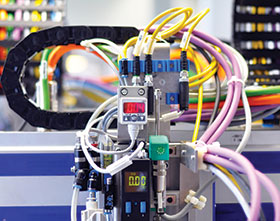

Customers often ask about data cable categories and what they mean. For many end-users, engineers and purchasing agents, who do not work with these types of cables on a daily basis, the different categories can seem complicated and overwhelming. However, what appears to be complex at first glance, can be simple to understand with a couple of tips. The category positively correlates with the data speed. i.e. the higher the category, the higher the possible frequency and the higher the frequency, the higher the possible data rate.
Data cable basics
One can compare category cables to a multi-lane road; the more lanes a road has, the more vehicles that are able to travel on this road concurrently. The standards are generally based on a maximum cable length of 100 m. This cable length consists of 90 m of installation cable and 10 m of patch cable. After the initial 100 m a repeater/extender is added to the cable system, which strengthens the signal and prepares it to be transmitted an additional 100 m as needed to connect the machine or its apparatus, and the control unit. Additionally, category data cables have to fulfil decoupling values of the pairs, e.g. near end cross talk (NEXT).
For Cat 5 cables, the decoupling of the pairs is realised in the cable construction with different twisting lengths of each pair. That means for four pairs, one has four individual twisting lengths during production.
Cat 6 cables allow users to choose between two technical designs. The relevant decoupling values of Cat 6 can be achieved with a plastic cross that creates distance between the pairs. Another way is to use a pair in metal foil (PIMF) construction. The thickness of the aluminium foil influences the effectiveness of the screen. Many people think that a screen in the construction protects the cable from environmental influences. However, it also has the opposite effect – the screen keeps the electrical signal in the cable and avoids negatively influencing other equipment in the vicinity.
For even higher categories, such as Cat 7, 7e, and 7A, a copper braid is mandatory to fulfil the standardised electrical values because an aluminium foil alone is not enough. Furthermore, each screening material has advantages and disadvantages.
Aluminium foil is inexpensive, but by itself this material does not perform well in applications that require flexible, track or torsion cables. If one moves a metal foil again and again one starts to see cracks, which decreases the effectiveness of the screening in the cable. This is the reason why some manufacturers construct cables that move frequently or are located in electromagnetic vulnerable (EMV) areas, using both an aluminium foil screen and a copper braid. This applies even to cables that are ‘only’ Cat 5 classification.
For cables with high amounts of bending cycles and small bending radii, some manufacturers use an additional metalised tape to fulfil effective screening. This is similar to a woven tape with integrated metalised parts, which offers longer lifespan without cracking compared to a standard aluminium foil.
Core material options
Let us now turn to a variety of possible core options, from both a material and stranding perspective. In most applications, bare copper is the preferred core material to use. However, in specific applications, such as the railway industry, a tinned copper core is preferred due to its higher corrosion resistance.
In terms of core stranding, solid cores are typically used in fixed installations, while flexible applications require a more nimble core which typically consists of seven strands. Flexible cores are used for drag chains and robotic applications with short lay length in order to achieve a more flexible cable and smaller bending radius. For the smallest bend radii and maximum cycle quantity/service life, customers can request to have data cables constructed with 19-strand cores. Having more strands in a core increases its flexibility; however, the best solution for a customer specific application should be discussed in consultation with the cable manufacturer.
Sheath material options
Cable sheath types are plentiful and can be narrowed down according to the application.
For cable installations in buildings, polyvinyl chloride (PVC) or flame retardant non-corrosive (FRNC) compounds are the typical choice of sheath material. PVC is not halogen free, but it is flexible and inexpensive. FRNC compounds meet the requirements of halogen-free and flame retardant, and emit a less optically dense smoke, which makes exiting a building easier and allows for improved firefighting operations in the event of a fire emergency.
Polyethylene (PE) sheaths are mainly used for outdoor cable applications or in cases where a cable needs to be buried into the ground. These cable sheaths are good at resisting moisture and exposure to the sun.
Due to the increase of data cables being used in industrial automation, it is common to use oil-resistant PVC blends, polyurethane (PUR) or thermoplastic elastomer (TPE) sheath compounds. These cable sheath types are preferred for their increased oil resistance, and ability to withstand the mechanical stresses often associated with the use of drag chains, and robotics. The choice of a particular compound or blend is based on the application and operating conditions.
Cable quality
Finally, it is highly recommended to use data cables that have had their mechanical capabilities extensively tested to withstand the rigors of operating in continuous-flex (drag chains) and torsion (robotics) applications. Data transmission rates can lessen, or signal quality could erode, due to cables that are unable to withstand strenuous operating conditions. Manufacturers should use a combination of test equipment, such as drag chains, torsion apparatuses, ovens and freezers, and, in some cases, specific application testing rigs, such as towers that mimic the strain and load on cables found inside wind turbines.
| Tel: | +27 11 462 8752 |
| Email: | [email protected] |
| www: | www.helukabel.co.za |
| Articles: | More information and articles about HELUKABEL |

© Technews Publishing (Pty) Ltd | All Rights Reserved